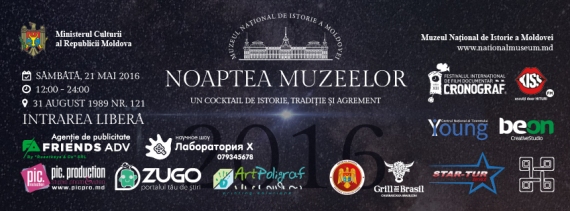European Night of Museums is an international event initiated by the Ministry of Culture and Communications of France. The Council of Europe, UNESCO and The International Council of Museums (ICOM) are the main supporters of the European Night of Museums. Over 4000 museums in Europe have joined this popular and long-lasting cultural event.

The National Museum of History of Moldova participated for the 11th time at the "Museum Night", event that unites museum institutions from Europe and which continue to gain interest from the visiting public.
The event organized on Saturday, 21st May from 12.00 until midnight had as generic „Museum Night 2016 - a cocktail of history, tradition and leisure".
The program included:
• Visiting museum exhibitions - "History and Civilization", "Treasures of the Past", "Weapons and Military Equipment - an Evolution throughout Centuries", "The Ambassador of Transdniestrian Molovata", "Soviet Moldavia - between Myths and the Gulag". The special offer of the Museum Night was the exhibition of porcelain from Hungary - "Shining Herend";
• Exhibition of sketches of technique from the 20th century. In this exhibition, organized especially for the Museum Night were presented 15 models from the museum collection (steam locomotive, aircrafts from the first half of the 20th century, cosmic device for the research of Moon surface, space ship „Soiuz", nuclear submarine, anti-submarine ship, tomato harvester, tractor „Vierul" etc.);
• Display of old and new motorcycles (12.00-18.00, in the courtyard of the museum). A collection of 15 bikes from the 20th and 21st centuries was presented, eight of which were produces in the years 1951-1991 („M-72", „M-61", „K-750", „K-750M", „Dnepr MT-9", „IJ 49", „Jawa 350");
• „CRONOGRAF" at the Museum - projections from the International Documentary Film Festival, 13th edition (14.00-22.40, film library „Clio")
- 14.00 Întoarcerea din modernitate / BACK FROM THE FUTURE (Romania), 48 min.;
- 15.30 Ține, doamne, partizanii, până vin americanii! / GOD SAVE THE PARTISANS AS WE WAIT FOR THE AMERICANS! (Romania), 62 min.;
- 18.30 Variațiuni pe un nume / VARIATIONS ON NAME (Republic of Moldova), 73 min.;
- 20.20 Sărmana de pe Prut / THE WIRED PRUT (Republic of Moldova), 52 min.;
- 21.40 Prizioneri ai fericirii / SLAVES OF HAPPINESS (Republic of Moldova), 56 min.;
• Master-class on clay modeling presented by ceramist Ivan Prividiuc (12.00-19.00, courtyard of the museum):
• Children club (12.00-19.00, courtyard of the museum)
- games and contests with awards;
- Scientific show „Laboratory X", with several entertaining experiments on water;
- „Câinii cu colaci în cozi", performance by the Republican Puppet Theater „Licurici". The actors have delighted both children and adults, carrying them into a world of fairytale;
• Music marathon „Rhythms of Museum Night" (14.00-22.30, courtyard of the museum)
- Galina Maleca and Ethno-folk group „Alină-te dor". The recital included authentic folk songs (14.00-14.30);
- Young talents singing at the museum, among them young performers Crista, Daniela, Dan Spasov and Anastasya and the band „Six Rounds" (16.00-18.30);
- Recital of Choir „Credo" of the Department of Carabinieri of MIA. The choir performed from the museum balcony, creating a totally unexpected music moment of intense emotional experience (19.00-19.15);
- Recital of classic music: String Quartet of Organ Hall. For about one hour the public enjoyed an extraordinary concert, a performance of elegance and virtuosity (20.00-20.55);
- Recital of blues by the band The Blue Dreamers (21.00-22.30).
 31 August 1989 St., 121 A, MD 2012, Chisinau, Republic of Moldova
31 August 1989 St., 121 A, MD 2012, Chisinau, Republic of Moldova




 The side panels are elegantly decorated with refined cast-iron elements in the Art Nouveau style, displaying the brand name - "Ideal." The Polyglott model, featuring a bilingual keyboard patented in the United Kingdom by Max Klaczko from Riga, Latvia, was produced between 1902 and 1913, marking the first typewriter capable of writing in two languages. The "Ideal Polyglott" typewriter was actively sold in the Russian Empire and gained significant popularity in Poland, Bulgaria, and Serbia.
The side panels are elegantly decorated with refined cast-iron elements in the Art Nouveau style, displaying the brand name - "Ideal." The Polyglott model, featuring a bilingual keyboard patented in the United Kingdom by Max Klaczko from Riga, Latvia, was produced between 1902 and 1913, marking the first typewriter capable of writing in two languages. The "Ideal Polyglott" typewriter was actively sold in the Russian Empire and gained significant popularity in Poland, Bulgaria, and Serbia.






































































